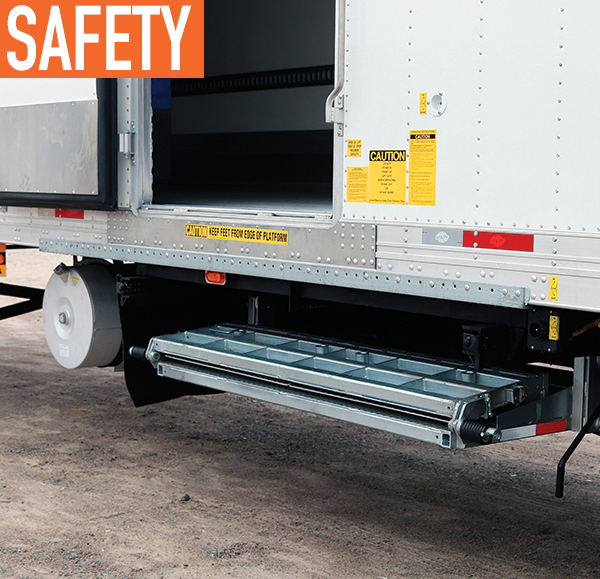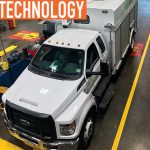Food distribution companies serving restaurants often use refrigerated (reefer) vehicles to deliver frozen and refrigerated groceries as well as dry goods. The cargo compartments of such reefer vehicles are commonly segregated into three chambers. The most forward chamber, usually closest to the refrigeration unit, is used for frozen cargo. The adjacent, usually mid-ship chamber is used for refrigerated cargo. Finally, the rearmost chamber is commonly used for dry and packaged foods.
A DILEMMA
Unloading a chambered vehicle presents its own set of problems. If unloading from the rear of the vehicle, workers moving frozen cargo must traverse the doors in the chamber barriers, taking care to open and close each, so as to maintain the monitored temperature guidelines associated with that chamber. Not only is rear unloading time-consuming and cumbersome, it requires a lot of physical exertion from the laborer, and while he or she is in a forward chamber, the roughly 8-ft by 8.5-ft rear cargo door remains open and the cargo unsecured.
In a situation where the entire vehicle is used for frozen or refrigerated cargo, opening the rear door for any extended time can greatly impact the vehicle’s internal temperature. With today’s heightened monitoring of cold chain variability, temperature fluctuation can not only cause carriers problems, but also negatively impact the viability of cargo, particularly in the case of certain foods and pharmaceuticals.
Once a worker brings the requisite cargo to the rear or side door of the trailer to unload, a ramp or hydraulic lift gate is usually used to allow the cargo to make the roughly 4-ft transition from the deck height of the trailer to ground level.
Ramps can extend as much as 12 feet from the rear or side of a vehicle, making them difficult to deploy in urban areas or tight spaces. Ramps can also become slippery in inclement weather, and if a heavy load must be moved up or down a ramp, it can be a physical and safety challenge for workers to maintain control.
Conversely, the lifting platforms of hydraulic lift gates extend only about six feet from the vehicle’s rear or side. While some lift gates feature retention barriers that prevent cargo from rolling off, many do not. Therefore, workers must be extra cautious when rolling cargo onto the lift gates, particularly if the lift gate is less stable and flexes under load.
MOMENTUM SHIFT
Leyman Manufacturing introduced the first patented side lift gate to the industry in 1981. The side lifts gained almost immediate acceptance among carriers serving dairies because they allowed heavy liquid cargos to quickly unload through smaller side doors, reducing temperature fluctuations and shortening the cargo’s overall route into stores.
“Our side lifts made it easier for carriers to quickly restock dairy shelves, increasing the volume of deliveries, while decreasing the carrier’s operating costs,” says Bill Margroum, vice president and general manager of Leyman Manufacturing. “You might say we helped make cold chains safer and more efficient before it was cool.”
Leyman’s side lift technology is particularly popular with major carriers serving restaurants. The time savings associated with a side lifting approach is particularly attractive in an industry where productivity and service are key.
“Mile Hi’s first exposure to Leyman came when we purchased a reefer with an older version of a Leyman lift gate on it,” explains Mike Blanton, vice president of Mile Hi Foods. “It worked so well that we decided we wanted to explore upfitting the rest of our fleet with side lifts and asked them to come out to discuss it with us.”
Mile Hi looked at Leyman’s latest LPS Hide-A-Way® Side Lift model and asked Leyman to explore some modifications that would be specific to Mile Hi and its planned side lift applications to 28-, 48- and 53-ft vehicles.
“I have to say, Leyman was really great to work with,” Blanton says. “Not only did they respond quickly with exactly what we wanted, they also worked with our internal maintenance team to train them on the equipment upkeep and best practices for repair. They still come out annually to update us and provide a refresher course.”
BEST OPTION
As Leyman’s side lifts gained popularity, other lift manufacturers soon entered the market. However, Leyman’s decades of side lift experience provided the company with insights and technical knowledge that enabled it to continue setting the pace for the industry.
“We essentially explored all side lift technology out there,” says Thomas Alexander, area fleet manager for one of the Western Hemisphere’s largest food distribution companies. “We found that when it came to platform design, stability, and safety, there simply wasn’t anything that quite compared to the Leyman LPS Hide-A-Way Side Lift.”
The LPS Hide-A-Way features gravity down gate action and two hydraulic cylinders to lift its 72- by 68-inch galvanized platform. Power is delivered via a stainless steel chain that is resistant to debris. The system’s adjustable out/up/stop power pack enclosure holds its hydraulic pump, motor, and has room for four batteries. It installs without the need to cut side rails and, when in use, provides a remarkably level lifting and lowering platform.
The LPS Hide-A-Way has greaseless bushings, potted marine toggle switch operation, and an automatic over-the-road lock that prevents the system from deploying while the vehicle is in motion. It comes with Leyman’s exclusive Maintenance Minder2® that records lift cycles and alerts users of voltage/amp fluctuations, temperature changes, and hose pressures. The system also alerts users of needed maintenance.
“Our workers feel safe and secure using the Leyman lift,” Alexander says. “That confidence lends itself to higher productivity and less stress for everyone.”
ECONOMICAL PERKS
“Fleets with loads that used to take anywhere from 45 minutes to an hour to unload can now move the same cargo in as little as 20 minutes,” Margroum says. “Productivity gains of 52% are common.”
Unlike some lift gates that require significant physical manipulation and effort to deploy, the LPS Hide-A-Way requires little if any operator assistance. The system slides out and into position quickly, and the spring-assisted split retainer ramps automatically form a safety barrier, so wheeled loads won’t roll off the platform edge. Once at ground level, the retainer ramps fold down, allowing cargo to smoothly roll off the platform’s low-profile 2-inch edge.
The system sells for roughly half the cost of a rear column lift gate and has up to 4,500 lbs of lifting capacity, while weighing only 1,650 lbs.
“Pound for pound, the LPS Hide-A-Way is one of the best productivity investments a fleet can make,” Margroum says. “We’re helping fleets of all kinds with solutions to their last-mile problems.”
Productivity gains are a critical factor in choosing a side lift, as well as day-to-day performance and total cost of ownership. In the field, the LPS Hide-A-Way demonstrated its ability to function flawlessly under even the most challenging conditions day after day. The system is even designed with an auxiliary operating mechanism that enables a user to manually retract the lift gate in case the system is damaged in the field.
Tested. Proven. Practical. It’s a side lift.
FOR MORE INFORMATION
Find out more about Leyman Manufacturing’s LPS Hide-A-Way Side Lift, visit www.leymanlift.com or call 866.539.6261.
MODERN WORKTRUCK SOLUTIONS: JUNE 2018 ISSUE
Did you enjoy this article?
Subscribe to the FREE Digital Edition of Modern WorkTruck Solutions magazine.
![]()








